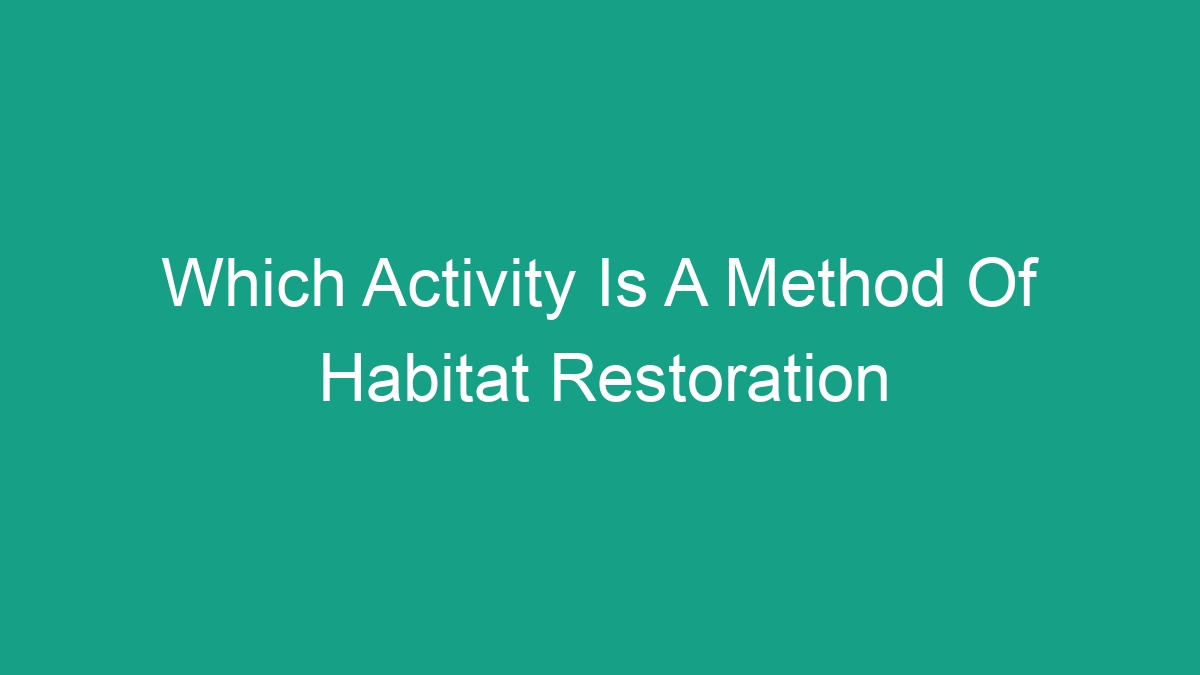
Introduction to Habitat Restoration
Habitat restoration is the practice of renewing and repairing ecosystems that have been damaged, degraded, or destroyed. It involves a range of activities aimed at returning a habitat to a healthy, functioning state, capable of supporting native wildlife and plants. One of the key questions often asked is, which activity is a method of habitat restoration? Let’s delve into some of the most effective methods used in habitat restoration.
1. Reforestation
Reforestation involves the planting of trees in areas that have been deforested or where natural tree cover has been significantly reduced. This activity is a vital method of habitat restoration as it helps to recreate the complex structure and diverse plant species typical of a healthy forest ecosystem. Reforestation also enhances biodiversity, improves soil quality, and provides habitat for a variety of wildlife.
2. Wetland Restoration
Wetlands are among the most productive and biologically diverse ecosystems on the planet. Unfortunately, they have been extensively drained, filled, and altered for agricultural and urban development. Wetland restoration involves re-establishing natural hydrology, removing invasive species, and replanting native vegetation. This method of habitat restoration is crucial for protecting water quality, providing flood control, and supporting a wide array of plant and animal species.
3. Stream and River Restoration
Stream and river restoration encompasses a range of activities aimed at improving the ecological health and functioning of these water systems. This may include restoring natural meander patterns, removing barriers to fish migration, and reintroducing native vegetation along stream banks. By restoring the natural flow and habitat structure of streams and rivers, this method of habitat restoration benefits fish populations, water quality, and overall ecosystem health.
4. Grassland and Prairie Restoration
Grasslands and prairies are incredibly diverse ecosystems that have been extensively converted to agricultural land or urban development. Restoring these habitats involves planting native grasses and wildflowers, managing invasive species, and reintroducing keystone animal species. Grassland and prairie restoration contributes to biodiversity, soil conservation, and provides essential foraging and nesting grounds for wildlife.
5. Coral Reef Restoration
Coral reefs are some of the most biologically diverse and economically valuable ecosystems on Earth, yet they are under severe threat from climate change, pollution, and overfishing. Coral reef restoration involves activities such as coral propagation, reef structure enhancement, and the creation of marine protected areas. This method of habitat restoration is vital for preserving the rich biodiversity and ecosystem services provided by coral reefs.
6. Urban Green Space Restoration
In urban environments, the restoration of green spaces such as parks, gardens, and urban forests can provide essential habitat for wildlife, offer recreational opportunities for communities, and contribute to improving air and water quality. Urban green space restoration involves planting native vegetation, creating wildlife habitats, and improving the ecological connectivity of urban areas.
Conclusion
Habitat restoration plays a crucial role in the conservation and sustainable management of ecosystems around the world. By employing methods such as reforestation, wetland restoration, stream and river restoration, grassland and prairie restoration, coral reef restoration, and urban green space restoration, it is possible to reverse the damage caused by human activities and create healthier, more resilient habitats for wildlife and plants.
FAQs
What are some key benefits of habitat restoration?
Habitat restoration helps to enhance biodiversity, improve ecosystem services such as water purification and flood control, and provide essential habitat for wildlife. It also contributes to carbon sequestration and the mitigation of climate change impacts.
How can individuals get involved in habitat restoration?
Individuals can participate in habitat restoration through volunteering with environmental organizations, engaging in community-based restoration projects, and supporting policies and initiatives that promote ecosystem conservation and restoration.
What are some challenges associated with habitat restoration?
Challenges include limited funding, invasive species management, and the need for long-term monitoring and maintenance of restored habitats to ensure their continued success.



